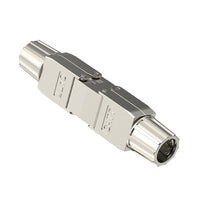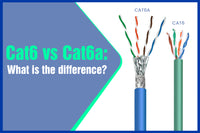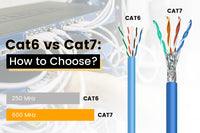Contents
To build a stable and reliable wired network, choosing a suitable category of Ethernet cable is very essential. With a plethora of options available in the market, ranging from Cat5e and Cat6 to Cat6a, and the cutting-edge Cat8, the decision-making process can be overwhelming. So, how to choose the best Ethernet cable for your home or business network? It's worth noting that opting for the latest standard cables isn't always a cost-effective solution.
In modern networking, Cat5e and Cat6 cables can stand out as the most prevalent options. Let's explore the distinctions between them and ascertain whether an upgrade is warranted for your network infrastructure. Read on to gain everything about these two Ethernet cable categories.
What is Cat5e Cable?
Cat5e, also known as Category 5e cable, represents an augmented version of Cat5 Ethernet cable. Cat5 Ethernet cable has been considered somewhat outdated, so it has been gradually replaced by the Cat5e cable. Released in 1999, the Cat5e standard has achieved a milestone by supporting the speed of 1 Gbps. It is the basic Ethernet cable in current network applications. Generally, Cat5e cables are unshielded and comprise four twisted pairs.

What is Cat6 Cable?
Category 6 cable was published by Telecommunications Industry Association (TIA) in 2002. Cat6 is the improved version of Cat5 and Cat5e, so it has a higher speed and bandwidth. These Cat6 cables come in both shielded and unshielded variants, providing users with flexibility in their network setups. With eight copper wires twisted into four pairs, Cat6 cables can deliver a speed of 1 Gbps within 180 feet (55 meters). Notably, the Cat6 cable is backward compatible with Cat5 and Cat5e cables. Cat6 cables are widely used in different scenarios, including home and office networks.

Cat5e and Cat6 Similarities
Cat6 cable is an upgraded version of Cat5e cable, so they also share several similarities:
- Both Cat5e and Cat6 can be terminated to T568A vs. T568B wiring standard according to your own need
- Both feature eight copper wires that are twisted into four pairs
- The maximum distance of both Cat5e and Cat6 is 100 meters (328 feet)
- Both of Cat5e and Cat6 can support PoE technology
- Both use RJ45 connectors (8P8C connectors) in network cabling
- Cat5e and Cat6 Ethernet cables can be shielded or unshielded
- High-quality Cat5e and Cat6 cables feature solid copper wires
Difference Between Cat5e and Cat6
Cat5e and Cat6 cables can look very similar in appearance, but in fact, they are different from each other. We have listed the key differences between these two categories of Ethernet cables in the following part.
Differences in Construction
When it comes to Cat5e and Cat6 Ethernet cables, both shielded and unshielded variations are available, but it's worth noting that the majority of Cat5e cables on the market tend to be unshielded. From the appearance, Cat6 cables are thicker than Cat5e cables.
As for inner construction, an unshielded Cat5e cable only features four twisted pairs and a ripcord. In contrast, an unshielded Cat6 cable features four twisted pairs, a ripcord, and a pair separator (spline). The spline is designed to mitigate crosstalk, making the Cat6 cable more resistant to interference and Near-End Crosstalk (NEXT) compared to the Cat5e cable. Almost all Cat5e cables are unshielded, while Cat6 cables have unshielded or shielded types. A shielded Cat6 cable will provide better insulation than a Cat5e cable.
Furthermore, Cat6 Ethernet cables features other strict specifications concerning crosstalk and noise, resulting in reduced interference, lower level of noise, as well as fewer errors. So, Cat6 cables are the preferred choice for applications where signal integrity is paramount.
Cat5e vs. Cat6: Which is Faster?
Cat5e and Cat6 are both twisted pair cables that use RJ45 connectors, technically known as 8P8C connectors, yet they have different performance characteristics. The frequency of the Cat5e cable is limited to 100 MHz, while the Cat6 cable can support a maximum bandwidth of 250 MHz. This makes the big difference between Cat5e and Cat6 as Cat6 cables do not only offer less interference and crosstalk but also provide higher data transmission speed.
Indeed, both Cat5e and Cat6 cable are capable of delivering transmission speeds of up to 1 Gbps if the distance is 100 meters (328 feet). But if the network cabling length is between 37~55 meters, Cat6 cables can achieve a data transmission rate of up to 10 Gbps. In this regard, Cat6 cables outperform Cat5e cables, providing superior speed and bandwidth over shorter distances.
Differences in Cost
The price of Cat5e and Cat6 cables differ by manufacturer, length, and quality, but Cat6 cables are generally 40% or 50% more expensive than Cat5e cables. But in regard of high speed, Cat6 cables are worth the price.
Cat5e vs. Cat6 Comparison Chart

Do I Need to Upgrade?
Now that you know the differences between Cat5e and Cat6, do you need to upgrade your network? Cat5e is good for most situations, but Cat6 cable can be better. Whether you want to install your home network, replace the old Ethernet cable, or find a future-proof cable, Cat6 can always be the preferred option.
If you love gaming and streaming, don't hesitate to choose Cat6 cables!
If you're about to install network in your new house, make the forward-thinking choice by opting for Cat6 cables. Your future self will thank you for this savvy investment in network infrastructure!
|
Applications |
Cat5e |
Cat6 |
|
Phone Lines |
✓ |
✓ |
|
Home Network |
✓ |
✓ |
|
Office Network |
✓ |
✓ |
|
Data Center |
✗ |
✗ |
Theoretically, Cat6 cables win concerning speed and performance. But not all networks can support higher speed. If your network devices cannot support 10 Gbps Ethernet, using a Cat6 cable will not change the situation. Some people think it is not worth investing in a high-performance Ethernet cable as the current network hardware doesn’t require a higher speed. Things can be different. Network devices are more accessible to upgrade than a new network.
In addition, the cost of installing the Cat6 cable is not very expensive than the Cat5e cable and Cat6 cables are backward compatible with Cat5e cables. So, why not choose the future-proofing Cat6 cable?

Another factor that you should consider is the quality of the Ethernet cable. Always go for a 100% copper cable for a stable and reliable network.
For more information on this topic, you can keep up on our blogs. While VCELINK offers general and basic information for our customers and other visitors to the website, it’s not professional advice.






Be the first one to comment.
Leave a comment